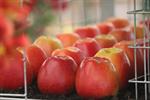LEARN TO GROW, HARVEST AND PRESERVE FRUIT AT HOME
 Grow an abundance of fresh fruit, berries and nuts, efficiently and economically. Preserve your harvest and trade or give away excess surplus produce to your friends and neighbours.
Grow an abundance of fresh fruit, berries and nuts, efficiently and economically. Preserve your harvest and trade or give away excess surplus produce to your friends and neighbours. - Learn how to raise soil fertility, choose the best fruits for your situation, and grow them in a way which controls pests and diseases without using dangerous chemicals.
- Cool and warm climate fruits are covered in this course; you are also given the option to concentrate your study on the types of fruits which are of most interest to you.
Lesson Structure
There are 6 lessons in this course:
-
Introduction
-
Soils, site preparation & planning.
-
General Cultural Practices
-
Tree Fruits
-
Nuts and Vines
-
Berries
What You Will Do
-
Research information you can within reason (eg: leaflets, booklets, details about advisory services etc) which relate to fruit growing in your locality.
-
Select part of a home garden where the owner would like to grow fruit. Consider the good and bad points about the site and the suitability of different types of fruits to the situation.
-
Take a sample of soil from an area you might consider growing fruit in. Using the method set out in the gardening manual provided with the course, name the soil.
-
Look at the buds on the wood of three different species of fruit. Draw what you see, and label where you think the buds are fruit buds, and where you think they are vegetative buds.
-
Observe the way in which fruit trees are trained or pruned in your locality.
-
Visit a local hardware store, nursery or irrigation shop and look at drip and micro irrigation equipment which is for sale. Take note of the various components of these systems, how they fit together and how they work.
-
Identify pests and diseases in a garden which you have visited.
-
Select different fruits from those you have read about which are grown in your area. For each one, research which varieties of that fruit are commonly grown, and why they are grown.
-
Plan the development of a berry growing area for a backyard. Contact companies, visit nurseries and check the availability, quality and prices of berry plants you would like to grow on your site (or proposed site). Work with an imaginary site if you do not have a real life situation to deal with.

Grow Fruit at Home for Year Round Consumption
There is nothing like fruit from your own garden. It’s quality and nutrition is generally better than fruit that you buy because it’s fresh (the food value can deteriorate as the fruit ages), and you can be certain about what chemicals it has, or has not been, exposed to. Apart from this, growing your own fruit is a lot of fun.
The trouble is, even just one mature fruit tree tends to give you so much fruit all at once that it’s difficult to know what to do with it. You can, of course, give some to friends, family and neighbours, and if you get organised, you might be able to swap. For example, you might grow the apples for the neighbourhood, and your neighbour grows the pears. Think about it … if everyone in your street put in a different fruit tree and shared the fruit around, you could all have fresh fruit for months on end.
Another alternative is to make your backyard hobby into a financial gain – why not sell excess fruit at the local markets or at street stalls.
Our gardens tend to have an excess of fruit during late summer and autumn. At this time of year, nectarines, peaches, plums, grapes, apples and pears are often available in glut quantities.
There are, however, other ways of dealing with an excess of fruit, and turning it into something that you can use all year round. Bottling your excess fruit into jams, pickles, chutneys, sauces are just a few options.
Who Can Benefit From This Course?
- Hobby farmers
- Those wanting to live a self sufficient lifestyle
- The backyard enthusiast
- Those wanting to set up a fruit garden
